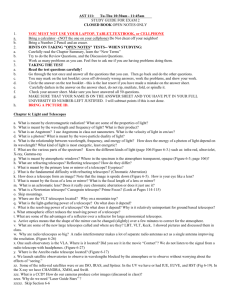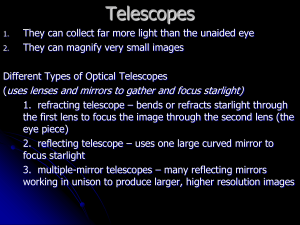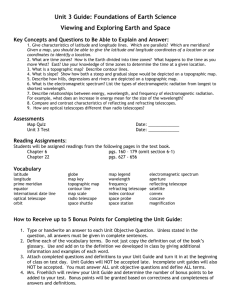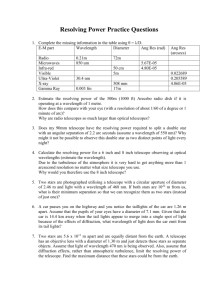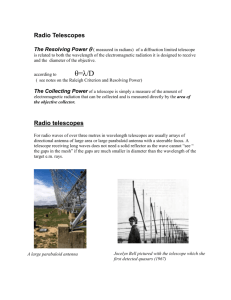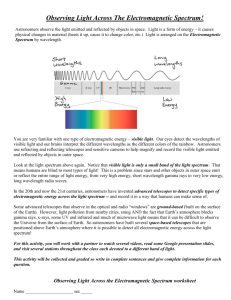AST 112 - Spring 2016 Tue - Thu 10:30
advertisement
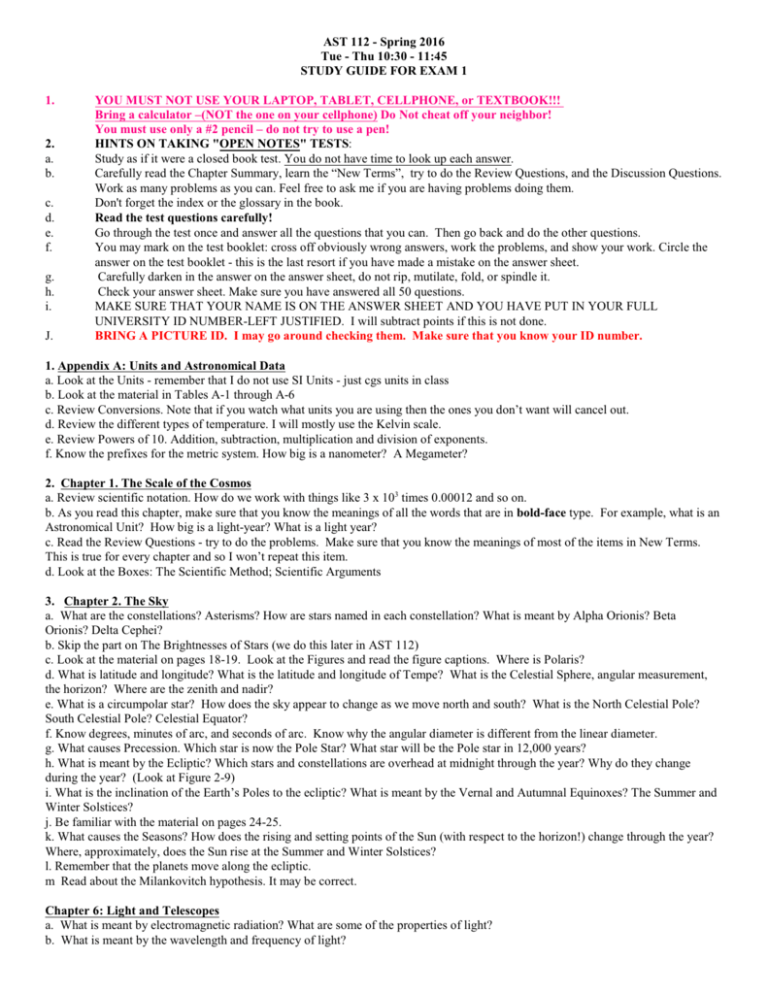
AST 112 - Spring 2016 Tue - Thu 10:30 - 11:45 STUDY GUIDE FOR EXAM 1 1. 2. a. b. c. d. e. f. g. h. i. J. YOU MUST NOT USE YOUR LAPTOP, TABLET, CELLPHONE, or TEXTBOOK!!! Bring a calculator –(NOT the one on your cellphone) Do Not cheat off your neighbor! You must use only a #2 pencil – do not try to use a pen! HINTS ON TAKING "OPEN NOTES" TESTS: Study as if it were a closed book test. You do not have time to look up each answer. Carefully read the Chapter Summary, learn the “New Terms”, try to do the Review Questions, and the Discussion Questions. Work as many problems as you can. Feel free to ask me if you are having problems doing them. Don't forget the index or the glossary in the book. Read the test questions carefully! Go through the test once and answer all the questions that you can. Then go back and do the other questions. You may mark on the test booklet: cross off obviously wrong answers, work the problems, and show your work. Circle the answer on the test booklet - this is the last resort if you have made a mistake on the answer sheet. Carefully darken in the answer on the answer sheet, do not rip, mutilate, fold, or spindle it. Check your answer sheet. Make sure you have answered all 50 questions. MAKE SURE THAT YOUR NAME IS ON THE ANSWER SHEET AND YOU HAVE PUT IN YOUR FULL UNIVERSITY ID NUMBER-LEFT JUSTIFIED. I will subtract points if this is not done. BRING A PICTURE ID. I may go around checking them. Make sure that you know your ID number. 1. Appendix A: Units and Astronomical Data a. Look at the Units - remember that I do not use SI Units - just cgs units in class b. Look at the material in Tables A-1 through A-6 c. Review Conversions. Note that if you watch what units you are using then the ones you don’t want will cancel out. d. Review the different types of temperature. I will mostly use the Kelvin scale. e. Review Powers of 10. Addition, subtraction, multiplication and division of exponents. f. Know the prefixes for the metric system. How big is a nanometer? A Megameter? 2. Chapter 1. The Scale of the Cosmos a. Review scientific notation. How do we work with things like 3 x 103 times 0.00012 and so on. b. As you read this chapter, make sure that you know the meanings of all the words that are in bold-face type. For example, what is an Astronomical Unit? How big is a light-year? What is a light year? c. Read the Review Questions - try to do the problems. Make sure that you know the meanings of most of the items in New Terms. This is true for every chapter and so I won’t repeat this item. d. Look at the Boxes: The Scientific Method; Scientific Arguments 3. Chapter 2. The Sky a. What are the constellations? Asterisms? How are stars named in each constellation? What is meant by Alpha Orionis? Beta Orionis? Delta Cephei? b. Skip the part on The Brightnesses of Stars (we do this later in AST 112) c. Look at the material on pages 18-19. Look at the Figures and read the figure captions. Where is Polaris? d. What is latitude and longitude? What is the latitude and longitude of Tempe? What is the Celestial Sphere, angular measurement, the horizon? Where are the zenith and nadir? e. What is a circumpolar star? How does the sky appear to change as we move north and south? What is the North Celestial Pole? South Celestial Pole? Celestial Equator? f. Know degrees, minutes of arc, and seconds of arc. Know why the angular diameter is different from the linear diameter. g. What causes Precession. Which star is now the Pole Star? What star will be the Pole star in 12,000 years? h. What is meant by the Ecliptic? Which stars and constellations are overhead at midnight through the year? Why do they change during the year? (Look at Figure 2-9) i. What is the inclination of the Earth’s Poles to the ecliptic? What is meant by the Vernal and Autumnal Equinoxes? The Summer and Winter Solstices? j. Be familiar with the material on pages 24-25. k. What causes the Seasons? How does the rising and setting points of the Sun (with respect to the horizon!) change through the year? Where, approximately, does the Sun rise at the Summer and Winter Solstices? l. Remember that the planets move along the ecliptic. m Read about the Milankovitch hypothesis. It may be correct. Chapter 6: Light and Telescopes a. What is meant by electromagnetic radiation? What are some of the properties of light? b. What is meant by the wavelength and frequency of light? c. What is an Angstrom? I use Angstroms in class not nanometers. What is the velocity of light in cm/sec? d. What is a photon? What is meant by the wave-particle duality of light? e. What is the relationship between wavelength, frequency, and energy of light? How does the energy of a photon of light depend on its wavelength? What kind of light is most energetic, least energetic? f. What are the various parts of the spectrum? Know the different kinds of light (page 106:Figure 6-3.) such as: infra-red, ultraviolet, X-ray, Gamma-ray I showed this in class. What molecules prevent some wavelengths of light from reaching the ground. g. What is meant by atmospheric windows? Where in the spectrum is the atmosphere transparent, opaque (Figure 6-3; page 106)? h. What are refracting telescopes? Reflecting telescopes? How do they differ? i. What is meant by the primary lens or mirror of a telescope? Eyepiece? j. What is the fundamental difficulty with refracting telescopes? (Chromatic Aberration) k. How does a telescope form an image? Note that the image is upside down (Figure 6-5). How is your eye like a telescope? l. What is meant by the focus of a lens or mirror? What is the focal length of a lens or mirror? m. What is an achromatic lens? Does it really cure chromatic aberration or does it just use it? n. What is a Newtonian telescope? Cassegrain telescope? Prime Focus? (Look at Pages 114-115) o. Skip mountings. p. In what country are the VLT telescopes located? The Keck telescopes? Why on a mountain top? q. What is the light-gathering power of a telescope? On what does it depend? r. What is the resolving power of a telescope? On what does it depend? Why is it relatively unimportant for ground based telescopes? What atmospheric effect reduces the theoretical resolving power of a telescope? What are some of the advantages of a reflector over a refractor for large astronomical telescopes. s. Active optics means that the shape of the mirror can be changed (slightly) over a few minutes to correct for the atmosphere. t. What are some of the new large telescopes called and where are they? LBT, VLT, Keck, ... I showed pictures and discussed them in class. u. Why are radio telescopes so big? A radio interferometer makes a lot of separate radio antennas act as a single antenna improving the resolution. One such observatory is the VLA. Where is it located? Did you see it in the movie “Contact”? We do not listen to the signal from a radio telescope with headphones. v. Where is the Arecibo radio telescope located? (Figure 6-17) w. We launch satellite observatories to observe in wavelengths blocked by the atmosphere or to observe without worrying about the effects of “seeing.” x. Some of the infra-red satellites were or are ISO, IRAS, Spitzer, and Herschel. In the UV we have or had IUE, EUVE, and HST (Fig 6-18). In the X-ray we have CHANDRA and XMM, and Swift (Figure 6-19). y. Skip Section 6-6 z. Try to do problem 3 on 128. Chapter 7. Starlight and Atoms. ( I did not do this Chapter in the order in the book) a. Remember the structure of an atom (nucleus with protons and neutrons plus electron(s) orbiting the nucleus) b. What is meant by neutral, ionized, electron shells. Remember that all matter consists of atoms. Each atom consists of a nucleus with electron(s) in orbit around the nucleus. c. The nucleus consists of proton(s) and neutron(s). Know what is meant by atomic number and atomic weight. What is an isotope? d. The Coulomb force binds the electrons to the nucleus. e. The various orbits around the nucleus are called energy levels because it takes energy to move away from the nucleus or the atom must give up energy for the electron to jump back toward the nucleus. Remember that only certain energies (distances from the nucleus) are permitted. (Stairway analogy) f. What is an excited atom? Ground state? g. The key concept about thermal emitters is that they emit radiation in a pattern that depends only on their temperature not their surfaces. So we ignore reflected light. h. Peak wavelength, which I use in class, is the same as wavelength of maximum intensity (p. 137). i. Look at Figure 7-6 in order to understand the three laws of thermal emission. Know the three “laws” as given in class. He leaves out the first one: That a hotter thermal emitter emits more energy at every wavelength than a cooler thermal emitter. j. What is the Stefan-Boltzmann Law? Wien’s Law? How can we use Wien’s Law to determine at what wavelength a thermal emitter radiates most strongly.? The value of the constant given in class is 5000 * 6000 because I use Angstroms not nanometers. k. Know Kirchhoff’s Laws as given on page 140-141: (1) A hot solid or dense gas produces a continuous spectrum. (2) A low density excited or hot gas produces a bright, emission line spectrum. (3) Put a low density gas in front of a continuous spectrum and you get a continuous spectrum with dark, absorption lines superimposed. l. Know emission and absorption lines and where and how they are formed. m. What is the Doppler Effect or Doppler Shift. How can we use it to tell whether an object is moving toward or away from us? What is meant by a blue shift? A red shift? n. Review the uses of the Doppler effect that I discussed in class. o. We will return later in the semester to use the Doppler formula p. Try to do problems 1 and 2 on page 145
